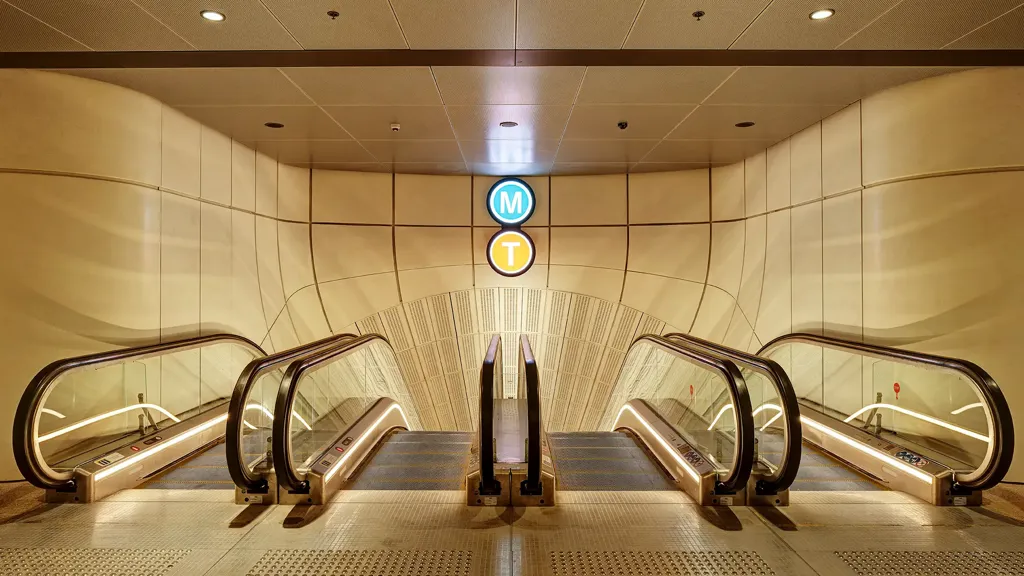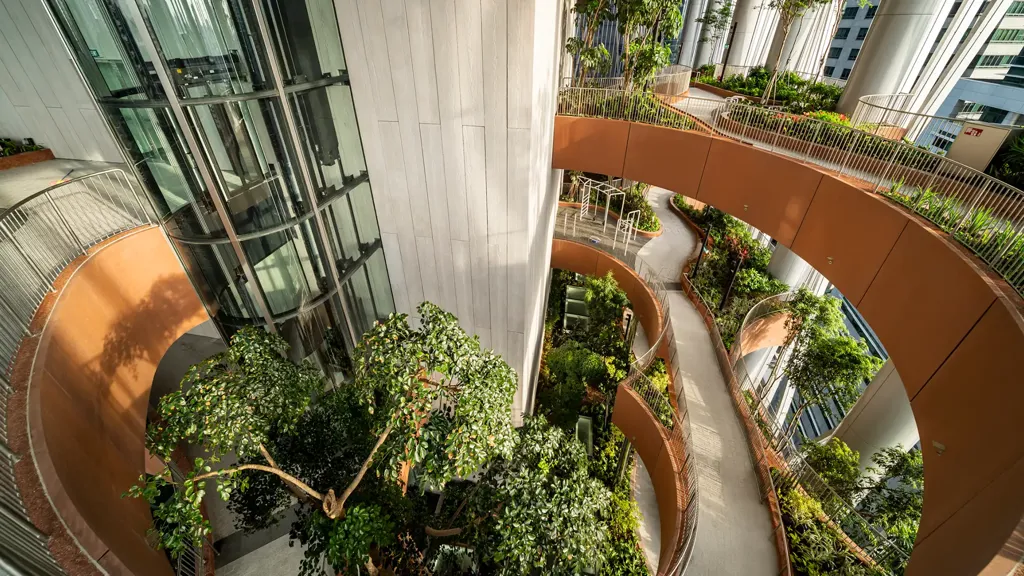What we delivered
-
Structural, MEP engineering and lighting design services.
Get in touch with our team
The Aizumi branch of Awa Bank, featuring an arc-shaped transparent façade, an open atrium and a light wooden space, opened in January 2023 in Tokushima, Japan. The 2-storey building, with a total floor area of 1,000m2, includes a visitor’s lobby and employees’ offices.
Arup provided structural, MEP engineering and lighting design services for this unique building.
Aizumi is witnessing a population growth, particularly among young families. The building design breaks from the traditional, authoritative bank image, aiming instead to be a friendly, accessible space for people of all ages. To accommodate future needs, such as changes in banking and working styles, we planned the office space on the second floor to be adaptable to layout changes without structural alterations.
Taking advantage of Tokushima’s mild climate and windy environment, we incorporated natural ventilation to mitigate reliance on air-conditioning and introduced ample daylight into the atrium lobby, creating a balanced interplay between natural and electric lighting.
Robust and lightweight structure
In response to the client’s request for a robust and safe impression, the building is designed with a reinforced concrete (RC) structure with earthquake-resistant walls arranged to withstand horizontal forces from events such as earthquakes and wind. The first floor, which is open to the public, features a column-free space, and the second floor is supported by steel rods suspended from large cross-section post-tensioned beams at the rooftop level with a timber concrete composite (TCC) slab.
To create a versatile and adaptable interior layout on the second floor office, partitions without load-bearing walls are employed, allowing flexible expansion of space.
Pioneering the use of innovative materials
The TCC slab is a structural member composed of cross-laminated timber (CLT) used as formwork with concrete poured on top. This environmentally-friendly floor system is lighter than traditional reinforced concrete floors, resulting in reduced load on the precast concrete (PC) beams supporting the second floor on the rooftop. Additionally, it allows for the structure to be used as a wood ceiling without modification. Being the first-of-its-kind in Japan, the TCC slab enables long spans that would be challenging to achieve with wood alone, while also contributing to a reduced carbon footprint for the entire building.





Validating the performance of TCC slabs
While TCC slabs are gaining popularity abroad due to their lighter weight and high rigidity, Japan lacked sufficient design formulas and research results to evaluate the synthetic effects of TCC. Therefore, in tandem with the project, Arup conducted research and development using internal funds. A comprehensive set of performance tests was carried out, mainly on TCC slabs, including elemental tests of joints, full-scale experiments and moisture content tests. In addition, overseas evaluation formulas were applied with necessary adjustments to validate the suitability of TCC slabs in Japan before their adoption.
Ensuring office comfort
In general, lightweight, long-span structures are susceptible to vibration disturbances caused by factors like pedestrian movement. To ensure office comfort, a detailed analytical study was conducted and vibrations were measured at key locations in the building after its completion. The results confirmed that the vibration levels were lower than predicted and that the deformation over time remained within the assumed adequate design values.
Given the constraints of the CLT structure, lighting fixtures and electrical wiring were integrated within the limited 60mm ceiling slot. As the lobby, which caters to customers, features a two-storey atrium space facing northwest, daylight simulations were conducted alongside electric lighting to establish an optimal balance between natural daylight and artificial illumination.
Sustainable and resilient systems
To accommodate the expansive CLT ceiling space, the building employs a variable refrigerant flow system and floor-blown air-conditioning on the first floor. Capitalising on Tokushima’s mild climate and strong winds, the curved front façade enhances wind flow, leveraging natural ventilation to reduce reliance on air-conditioning. Solar panels on the rooftop further the building’s energy-saving efforts. Furthermore, an emergency power generator has been installed to provide a back-up power supply, allowing for limited operations in the event of a power outage.
Architect: Nobuaki Furuya+NASCA
Projects
Explore more property projects

Technical design advice to ensure the functionality and viability of Dubai's new super slender skyscraper
Muraba Veil, United Arab Emirates

Designing Sydney’s first integrated station development
Sydney Metro Martin Place integrated station development, Australia

An iconic landmark shaping the future for office buildings
The Henderson Building, Hong Kong

CapitaSpring uses biophilic design to keep people cool and healthy
CapitaSpring, Singapore
Get in touch with us
If you'd like to speak to one of our property experts about any of the issues raised on this page or a potential collaboration then please get in touch by completing the form.


